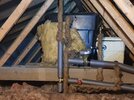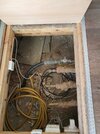Hi all,
I’ve moved into a new house that has an open vented heating system, I’m looking or a bit of help understanding the system so I can isolate and drain the radiators ahead of swapping out a very old one.
There’s large cold-water tank in my loft, plus another small one beside it. Is the small one where the radiators top from? There's a valve on it that I could turn off. Photo attached.
There’s 3 drain points below a hatch at my front door. One ran clean hot water, one dirty warm water, there wasn’t much anything came out the third. I’m guessing the hot water cylinder, the radiators, what would the third be for? Photo also attached.
Any pointers would be appreciated!
Cheers
I’ve moved into a new house that has an open vented heating system, I’m looking or a bit of help understanding the system so I can isolate and drain the radiators ahead of swapping out a very old one.
There’s large cold-water tank in my loft, plus another small one beside it. Is the small one where the radiators top from? There's a valve on it that I could turn off. Photo attached.
There’s 3 drain points below a hatch at my front door. One ran clean hot water, one dirty warm water, there wasn’t much anything came out the third. I’m guessing the hot water cylinder, the radiators, what would the third be for? Photo also attached.
Any pointers would be appreciated!
Cheers



